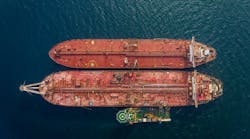Paula Dittrick
OGJ Senior Staff Writer
HOUSTON, June 17 -- A different containment cap will be included as part of BP PLC’s efforts to install more hurricane-durable systems for collecting oil from the runaway Macondo well in the deepwater Gulf of Mexico.
National Incident Commander and retired US Coast Guard Adm. Thad Allen said plans call for the Discoverer Enterprise drillship and the Q4000 multiservice vessel eventually to be disconnected from the well so that a new containment cap can be put into place.
The existing lower marine riser package (LMRP) cap allows some leakage. Allen said an “absolute cap that would allow no oil to escape” will be installed, enabling greater collection capacity.
The new cap is expected to be installed while the collection delivery system is switched from fixed risers to floating risers. Equipment and vessels are coming from Brazil and the North Sea to set up the floating riser systems, Allen said.
Floating risers will enable surface vessels to disconnect from the system if needed in case a hurricane hits the gulf. The spill response will be the first time that floating risers have been used in the gulf, Allen said.
“We think this is low-risk, but it takes a long time to get the equipment,” he said.
Q4000 collecting, burning oil
The LMRP cap is connected to a fixed riser that connects with the Enterprise on the surface. The Q4000 direct connect involves a seafloor manifold that is connected to the failed Deepwater Horizon BOP. Earlier this week, the Q4000 started receiving oil in addition to volumes being collected on the Enterprise (OGJ Online, June 16, 2010).
BP will have the capacity to capture about 28,000 b/d “sometime early next week,” Allen said during a June 17 conference call. The Q4000 uses a specialized clean-burning system to flare both oil and gas. On the Enterprise, gas is flared and the oil is moved to a lightering vessel for delivery to Mobile, Ala.
By June 30 BP hopes to have installed containment enhancements to provide a collection capacity of 40,000-53,000 b/d. By mid-July, BP hopes to have a system with a collection capacity of 60,000-80,000 b/d.
The containment systems are temporary measures until completion of at least one of two relief wells being drilled. The anticipated relief well completion date is sometime in August.
The Development Driller III, which is drilling the first relief well, has reached a depth of more than 15,000 ft and is 11 days ahead of schedule, Allen said.
According to a June 16 news release from the Deepwater Horizon Incident Joint Information Center, the relief well being drilled by Development Driller III is beginning to angle at 23º. Meanwhile, the Development Driller II has drilled the second relief well to a depth of 9,774 ft. The Macondo well was drilled to 18,000 ft.
Contact Paula Dittrick at [email protected].
